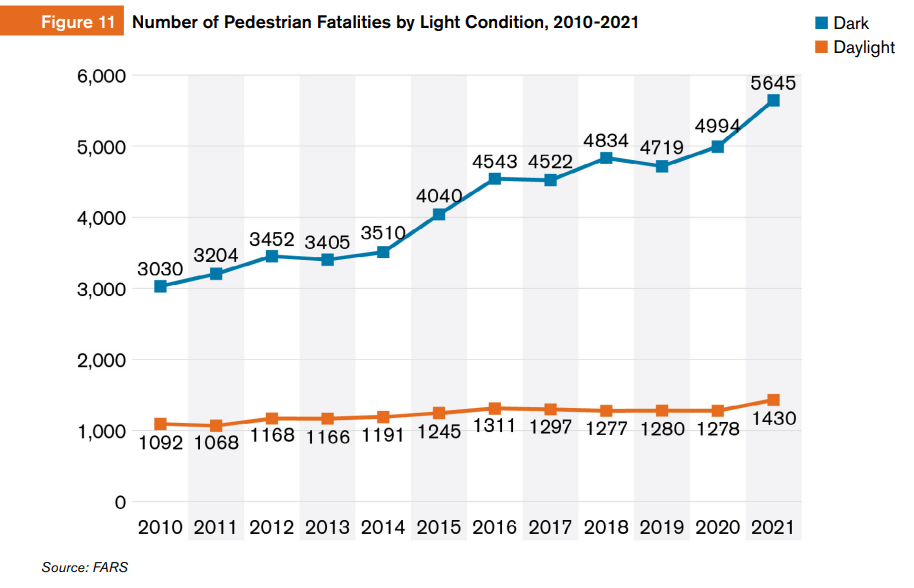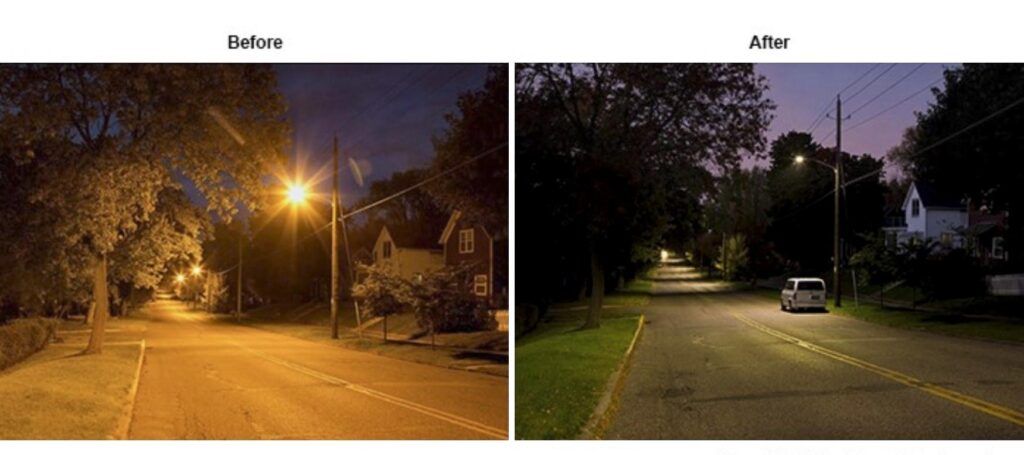The Streetlight Effect: Modern Considerations of Early Observations in the Psychology of Outdoor Lighting
By Noah Sabatier
It’s no secret that people don’t enjoy searching for something in the dark. Shadows dance, shapes shift and forms seemingly appear out of nowhere. The Streetlight Effect originated as an early 1900s anecdote in which a drunken man is searching for his keys. A police officer helps him search, resulting in both men spending several minutes under a streetlight. When the officer asks if the drunken man lost his keys under the streetlight he replies “no, this is where the light is”.
The stakes become much higher while driving, when individuals have mere seconds to see, identify and react to obstacles. This visual ability can be the difference between life and death, as new statistics suggest. 2022 saw a 40-year high of pedestrian deaths in the US, with the trend growing at an alarming rate. Commonly blamed for this rise in pedestrian fatalities is mobile device usage by drivers and the gradual increase in average vehicle size. The statistics paint a different picture however;

While these statistics don’t reveal the cause of every fatality, we can safely conclude that vehicles do not magically shrink after sunset, nor do mobile devices vanish at night. With such a sharp rise specifically in nighttime fatalities we need to ask; What went wrong with roadway lighting and vehicle headlights?
Research on driver behavior confirms the aforementioned streetlight effect. In 2013 the gaze direction of drivers was examined on a stretch of road during day and night. During daylight hours when sunlight provided illumination of the entire scene, horizontal gaze direction extended beyond either edge of the road. This changed for night driving tests, in which gaze patterns shrunk to match the areas illuminated by headlights and streetlights. There was little to no desire for drivers to spend precious seconds gazing around unlit areas, nor was there a visual stimulus to draw the attention of visual gaze.
Further research conducted in 2015 examined the visual behavior of drivers by tracking both their head movements and eye movements to establish gaze direction. 2 roads were utilized for testing, a main route and a residential street both illuminated by streetlights. Collected data revealed that drivers consciously adjust their gaze based on anticipated hazards and vehicle speed. Driving down a main route, the driver’s gaze was narrowed and more time was spent focusing down the road. In the residential area, more time was spent scanning the near side of the road as well as regions where other cars or pedestrians could enter the vehicle’s path.
Proper understanding of driver gaze behavior is important, as improper lighting can reduce a driver’s ability to detect targets before they enter the roadway. With the majority of LED fixtures sporting a lower efficacy than the sodium lights they replaced, especially in early transitions, their energy savings relied on illuminating a smaller area to a lower level of luminance. While this is a case-by-case issue for different transitions, common trends can be observed. In many cases the illumination of sidewalks was reduced, both behind and infront of LED streetlights. In fewer cases, dark spots were created between light posts where the LED light was unable to match the illumination area of the previous sodium light fixture. Neither of these are mistakes, as a primary selling feature of LED fixtures is energy savings through tighter illumination patterns.

Understanding both visual psychology and the biological mechanics of the retina is critical to implementing lighting optimally. For an industry and professional field increasingly focused on reducing light pollution, minimizing illuminated areas is often considered a primary goal. Caution must be used however, as research reveals that driver gaze extends beyond the roadway in anticipation of hazards based on the driving scenario. Should new lighting systems reduce luminance levels on a sidewalk or highway shoulder, drivers may lose their ability to detect hazards before they enter the vehicle’s path. If the goal of visibility and safety is a priority for the lighting field, our gaze must widen to issues of visual system psychology.
Noah Sabatier is a photographer and lighting researcher that is dedicated to advocating for better outdoor lighting. Noah has spent the past 5 years living with a night shift sleep schedule, during this time he realized that the streetlights in his city were far from optimal – and recent changes had only made them worse. He has spent the past 2 years extensively reviewing scientific literature and technical documents alongside others advocating for better lighting. Noah is now working to raise awareness of common misconceptions that lead to bad lighting and the better practices needed to solve this problem.
Works Cited: